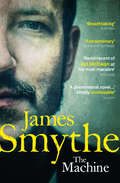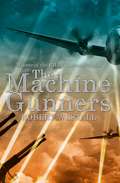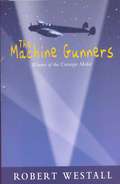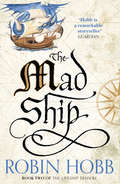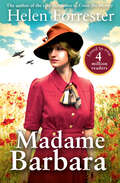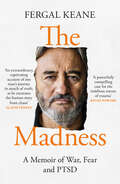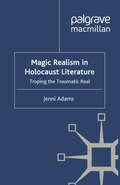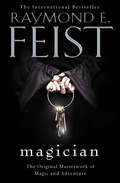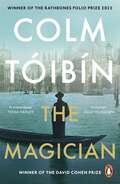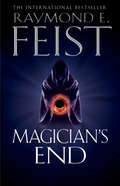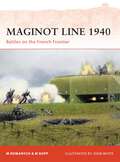- Table View
- List View
The Machine
by James SmytheShortlisted for the Arthur C Clarke Award 2014, this is a Frankenstein tale for our time from one of the UK’s brightest new literary talents.
The Machine
by James SmytheShortlisted for the Arthur C Clarke Award 2014, this is a Frankenstein tale for our time from one of the UK’s brightest new literary talents.
The Machine Gunners (Macmillan Collector's Library #80)
by Robert Westall'Some bright kid's got a gun and 2000 rounds of live ammo. And that gun's no pea-shooter. It'll go through a brick wall at a quarter of a mile.' Chas McGill has the second-best collection of war souvenirs in Garmouth, and he desperately wants it to be the best. When he stumbles across the remains of a German bomber crashed in the woods - its shiny, black machine-gun still intact - he grabs his chance. Soon he's masterminding his own war effort with dangerous and unexpected results . . . The Machine Gunners is Robert Westall's gripping first novel for children set during World War Two and winner of the Carnegie Medal. Now with a brilliant cover look celebrating its fortieth anniversary. Includes a bonus short story - 'The Haunting of Chas McGill' - and an extended biography of the author.
The Machine Gunners (PDF)
by Robert WestallChas McGill is living in WWII Britain. He has the second-best collection of war souvenirs, only rivalled by Boddser Brown. Chas wants to beat Boddser more than anything, and his search for the ultimate souvenir leads him into the woods where he finds a crashed German bomber-with its machine gun still attached. All Chas has to do is remove the gun, then not only will he beat Boddser hands down, but he can play a real role in the war effort. . .
Machine Guns: An Illustrated History of Their Impact (Weapons and Warfare)
by James H. WillbanksThe machine gun—often called the killing machine—revolutionized modern ground combat, brought an end to the traditional infantry and cavalry charge, and changed the battlefields of war forever.This volume in the Weapons and Warfare series describes the history of machine guns from the mid-19th century to the present, following both the evolution of small arms technology and the impact of machine guns on the battlefield, on military strategy, and on human society.This book discusses subjects ranging from the forerunners of mechanical and automatic guns, to the unusual history of the Civil War-era Gatling gun (the first practical machine gun, not used by the Union army because Gatling was a Southerner), to the machine guns developed for the world wars and those for present day use. Readers will see how the advent of the machine gun revolutionized ground combat—and how in some instances, technology outran tactics and doctrines, with disastrous consequences.
Mackenzie's Heroes: Mackenzie's Pleasure Mackenzie's Magic (Heartbreakers Ser. #5)
by Linda HowardMackenzie's Pleasure
A Mad Catastrophe: The Outbreak of World War I and the Collapse of the Habsburg Empire
by Geoffrey WawroA masterful account of the Hapsburg Empire's bumbling entrance into World War I, and its rapid collapse on the Eastern FrontThe Austro-Hungarian army that attacked Russia and Serbia in August 1914 had a glorious past but a pitiful present. Speaking a mystifying array of languages and lugging obsolete weapons, the Habsburg troops were hopelessly unprepared for the industrialized warfare that would shortly consume Europe. As prizewinning historian Geoffrey Wawro explains in A Mad Catastrophe, the disorganization of these doomed conscripts perfectly mirrored Austria-Hungary itself. For years, the Empire had been rotting from within, hollowed out by complacency and corruption at the highest levels. When Germany goaded Austria into starting the world war, the Empire's profound political and military weaknesses were exposed. By the end of 1914, the Austro-Hungarian army lay in ruins and the course of the war seemed all but decided. Reconstructing the climax of the Austrian campaign in gripping detail, A Mad Catastrophe is a riveting account of how Austria-Hungary plunged the West into a tragic and unnecessary war.
Mad Joy
by Jane BaileyA heart-warming and passionate tale from the author of Tommy Glover's Sketch of HeavenAt the age of five I ran into a wood, and nearly two years later I walked out of it and into the nearest house.In 1927, Gracie returns to her house to find a young girl curled up on her armchair: a feral, rather grubby gift of fate. With no knowledge of the child's origins and no children of her own, Gracie adopts her and names her 'Joy'. Despite the endless speculation about Joy's unusual ways, Gracie is happy to remain ignorant about her past in case anyone should come forward to reclaim her as their own. Time passes and Joy grows into a young woman at the advent of World War II. But when she becomes romantically involved with a fighter pilot the mystery of her past slowly unravels . . .Praise for Jane Bailey'A vivid and involving novel that reaches a truly page-turning climax' Barbara Trepido'Absorbing, compelling and intensely moving' Lesley Glaister, author of As Far as You Can Go'A gentle, poignant, achingly funny tale of displaced children, first love and the tragic secrets hidden behind so many respectable facades' Serena Mackesy, author of The Temp
Mad Mitch's Tribal Law: Aden and the End of Empire
by Aaron EdwardsAden, 20 June 1967: two army Land Rovers burn ferociously in the midday sun. The bodies of British soldiers litter the road. Thick black smoke bellows above Crater town, home to insurgents who are fighting the British-backed Federation government. Crater had come to symbolise Arab nationalist defiance in the face of the world’s most powerful empire. Hovering 2,000 ft. above the smouldering destruction, a tiny Scout helicopter surveys the scene. Its passenger is the recently arrived Commanding Officer of the Argyll and Sutherland Highlanders, Lieutenant-Colonel Colin Mitchell. Soon the world’s media would christen him ‘Mad Mitch’, in recognition of his controversial reoccupation of Crater two weeks later.Mad Mitch was truly a man out of his time. Supremely self-confident and debonair, he was an empire builder, not dismantler, and railed against the national malaise he felt had gripped Britain’s political establishment. Drawing on a wide array of never-before-seen archival sources and eyewitness testimonies, Mad Mitch’s Tribal Law tells the remarkable story of inspiring leadership, loyalty and betrayal in the final days of British Empire. It is, above all, a shocking account of Britain’s forgotten war on terror.
The Mad Ship: Ship Of Magic; Mad Ship; Ship Of Destiny (The Liveship Traders #2)
by Robin Hobb'Even better than the Assassin books. I didn't think that was possible' George R.R. Martin
Madame Barbara (Windsor Selection Ser.)
by Helen ForresterTimeless romance from the best-selling author of Tuppence to Cross the Mersey. With over 3 million copies sold around the world, Helen Forrester’s heart-warming and gripping fiction, set in post-war Liverpool and France, continues to move readers.
Made, Not Born: Why Some Soldiers Are Better Than Others (Praeger Security International)
by Bruce NewsomeWhy do the combat capabilities of individual soldiers vary so much? This book seeks to provide an answer to this and other questions about variability in combat performance. Some soldiers flee quickly from the battlefield, while others endure all hardships until the bitter end. Some combat units can perform numerous types of missions, while others cannot keep themselves organized during peacetime. Some militaries armed with obsolete weapons have out fought enemies with the latest weapons, just as some massively outnumbered armies have beaten back much larger opponents. In this first social scientific study of the effectiveness of combat troops, Newsome evaluates competing explanations for the varying combat capabilities and performances.There are four main explanations, each emphasizing the influence of a single factor. The first focuses on material endowments. How well funded are the troops? Do they have the latest protective gear and the most advanced weaponry? Second, some analysts claim that democracies produce better commanders, superior strategies, more motivated personnel, or better-managed personnel; others, however, associated those characteristics with more authoritarian forms of government. Third is the idea that giving more power to the troops on the ground in individual combat units empowers them with decision-making capability and adaptability to fast-changing situations and circumstances. Newsome presents evidence that decentralized personnel management does correlate with superior combat performance. Fourth, soldier capabilities and performance often are assumed to reflect intrinsic attributes, such as prior civilian values. Newsome argues that the capabilities of combat soldiers are acquired through military training and other forms of conditioning, but he does not entirely discount the role of a soldier's individual character. In the age-old nature vs. nurture argument, he finds that intrinsic qualities do count, but that extrinsic factors, such as training and environment, matter even more.
The Madman in the White House: Sigmund Freud, Ambassador Bullitt, and the Lost Psychobiography of Woodrow Wilson
by Patrick Weil“A rich study of the role of personal psychology in the shaping of the new global order after World War I. So long as so much political power is concentrated in one human mind, we are all at the mercy of the next madman in the White House.”—Gary J. Bass, author of The Blood TelegramThe notorious psychobiography of Woodrow Wilson, rediscovered nearly a century after it was written by Sigmund Freud and US diplomat William C. Bullitt, sheds new light on how the mental health of a controversial American president shaped world events.When the fate of millions rests on the decisions of a mentally compromised leader, what can one person do? Disillusioned by President Woodrow Wilson’s destructive and irrational handling of the 1919 Treaty of Versailles, a US diplomat named William C. Bullitt asked this very question. With the help of his friend Sigmund Freud, Bullitt set out to write a psychological analysis of the president. He gathered material from personal archives and interviewed members of Wilson’s inner circle. In The Madman in the White House, Patrick Weil resurrects this forgotten portrait of a troubled president.After two years of collaboration, Bullitt and Freud signed off on a manuscript in April 1932. But the book was not published until 1966, nearly thirty years after Freud’s death and only months before Bullitt’s. The published edition was heavily redacted, and by the time it was released, the mystique of psychoanalysis had waned in popular culture and Wilson’s legacy was unassailable. The psychological study was panned by critics, and Freud’s descendants denied his involvement in the project.For nearly a century, the mysterious, original Bullitt and Freud manuscript remained hidden from the public. Then in 2014, while browsing the archives of Yale University, Weil happened upon the text. Based on his reading of the 1932 manuscript, Weil examines the significance of Bullitt and Freud’s findings and offers a major reassessment of the notorious psychobiography. The result is a powerful warning about the influence a single unbalanced personality can have on the course of history.
Madness Visible: A Memoir of War
by Janine Di GiovanniAward-winning journalist Janine di Giovanni spent much of the 1990s observing the cycles of violence and vengeance from inside Balkan cities and villages, refugee camps and makeshift hospitals. This was a conflict that raised challenging questions: what causes neighbours, whose families have lived peacefully for centuries, to turn with mindless brutality against one another? How do we measure the difference between bravery and cowardice in a conflict so morally ill-defined? What becomes of survivors when the fabric of an age-old community is destroyed? Searching for answers, di Giovanni brings the reality of war into focus: children dying from lack of medicine, women driven to despair and madness by their experiences in paramilitary rape camps and soldiers numbed by and inured to the atrocities they committed. In Madness Visible she paints an indelible portrait of the Balkans under siege and shows the true - human - cost of war.
Magic Flutes
by Eva IbbotsonSpring, 1922Tessa is a beautiful, tiny, dark-eyed princess - who's given up her duties to follow her heart, working for nothing backstage at the Viennese opera. No one there knows who she really is, or that a fairy-tale castle is missing its princess, and Tessa is determined to keep it that way.But secret lives can be complicated, and when a wealthy, handsome Englishman discovers this bewitching urchin backstage, Tessa's two lives collide - and in escaping her inheritance, she finds her destiny. . .Magic Flutes is an enchanting story of love, music and secret princesses from Eva Ibbotson.
Magic Realism in Holocaust Literature: Troping the Traumatic Real
by J. AdamsA major contribution to Holocaust studies, the book examines the capacity of supernatural elements to dramatize the ethical and representational difficulties of Holocaust fiction. Exploring texts by such writers as D.M. Thomas and Markus Zusak it will appeal to scholars and students of Holocaust literature, magic realism, and contemporary fiction.
Magician: Apprentice (The Riftwar Saga #1)
by Raymond E. FeistMagician, available in ebook for the first time, is a masterwork of magic and adventure. The whole of the magnificent Riftwar Cycle, by bestselling author Raymond E. Feist, is now available in ebook
The Magician: Winner of the Rathbones Folio Prize
by Colm TóibínFrom one of our greatest living writers comes a sweeping novel of unrequited love and exile, war and family.The Magician tells the story of Thomas Mann, whose life was filled with great acclaim and contradiction. He would find himself on the wrong side of history in the First World War, cheerleading the German army, but have a clear vision of the future in the second, anticipating the horrors of Nazism.He would have six children and keep his homosexuality hidden; he was a man forever connected to his family and yet bore witness to the ravages of suicide. He would write some of the greatest works of European literature, and win the Nobel Prize, but would never return to the country that inspired his creativity.Through one life, Colm Tóibín tells the breathtaking story of the twentieth century.___________________________________'As with everything Colm Tóibín sets his masterful hand to, The Magician is a great imaginative achievement -- immensely readable, erudite, worldly and knowing, and fully realized' - Richard Ford'No living novelist dramatizes artistic creation as profoundly, as luminously, as Colm Tóibín . . . reading him is among the deepest pleasures our literature can offer' - Garth Greenwell'This is not just a whole life in a novel, it's a whole world' - Katharina Volckmer
Magician’s End: Book Three Of The Chaoswar Saga (The Chaoswar Saga #3)
by Raymond E. FeistDiscover the fate of the original black Magician, Pug, as prophecy becomes truth in the last book of the Riftwar Cycle.
Maginot Line 1940: Battles on the French Frontier (Campaign #218)
by Marc Romanych Martin RuppConstructed throughout the 1930s, the Maginot Line was supposed to form the ultimate defence against a German invasion of France. However, different sections of the line were built at different times and the strength of various sections varied widely. During their Blitzkrieg invasion, the Germans were able to identify these weak points and focus their attacks against them. This book uses new maps and period photographs to tell the story of the five German operations launched against the Maginot Line. While the Germans were able to smash through the lightly defended section of the line along the Meuse River, at other points the line held. Although ultimately the Maginot Line was to prove a failure, the stiff resistance put up by some of the fortresses confirms the fighting ability of the French army during the invasion.
Maginot Line 1940: Battles on the French Frontier (Campaign)
by John White Marc Romanych Martin RuppConstructed throughout the 1930s, the Maginot Line was supposed to form the ultimate defence against a German invasion of France. However, different sections of the line were built at different times and the strength of various sections varied widely. During their Blitzkrieg invasion, the Germans were able to identify these weak points and focus their attacks against them. This book uses new maps and period photographs to tell the story of the five German operations launched against the Maginot Line. While the Germans were able to smash through the lightly defended section of the line along the Meuse River, at other points the line held. Although ultimately the Maginot Line was to prove a failure, the stiff resistance put up by some of the fortresses confirms the fighting ability of the French army during the invasion.
Maginot Line Gun Turrets: And French gun turret development 1880–1940 (New Vanguard)
by Donato Spedaliere Clayton DonnellThe Maginot Line was one of the most advanced networks of fortifications in history. Built in the aftermath of World War I, and stretching along the French eastern border from Belgium to Switzerland, it was designed to prevent German troops from ever setting foot on French soil again.Its primary defensive weapons were the gun turrets. Beginning development in the 1870s and improving on German designs, they were constructed out of steel wedges and could revolve and disappear from sight after firing, making them impervious to enemy bombardment. They were deadly accurate and created havoc on the German units that attacked the line during their invasion of France in 1940.This fully illustrated study will examine the technical details of the French artillery turrets. It will show the evolution of the design of the guns and turrets used in the French forts before and during World War I, then those built exclusively for the Maginot Line to give a comprehensive overview of the weapons designed to protect France from invasion.
Maginot Line Gun Turrets: And French gun turret development 1880–1940 (New Vanguard)
by Donato Spedaliere Clayton DonnellThe Maginot Line was one of the most advanced networks of fortifications in history. Built in the aftermath of World War I, and stretching along the French eastern border from Belgium to Switzerland, it was designed to prevent German troops from ever setting foot on French soil again.Its primary defensive weapons were the gun turrets. Beginning development in the 1870s and improving on German designs, they were constructed out of steel wedges and could revolve and disappear from sight after firing, making them impervious to enemy bombardment. They were deadly accurate and created havoc on the German units that attacked the line during their invasion of France in 1940.This fully illustrated study will examine the technical details of the French artillery turrets. It will show the evolution of the design of the guns and turrets used in the French forts before and during World War I, then those built exclusively for the Maginot Line to give a comprehensive overview of the weapons designed to protect France from invasion.
Magna Carta: The True Story Behind the Charter
by David Starkey'A soaring account of the months that transformed a messy feudal squabble into Magna Carta...his crisp storytelling, based around short chapters and rolling rhetoric, is extremely entertaining.' Dan Jones, Mail on Sunday'I thoroughly enjoyed this book. Good history is descriptive, narrative and analytical. This is good history.' Gerard DeGroot, The TimesAt Runnymede, on the banks of the River Thames, on 15 June 1215, the seal of King John was attached to the Magna Carta, and peace descended upon the land. Or that's what successive generations have believed. But is it true? And have we been persuaded (or persuaded ourselves) that the events of 15 June 1215 not only ended a civil war between the king and the barons but - as if by magic - established a British constitution beloved and copied throughout the world?Often viewed as a victory for the people over the monarchy and a cornerstone of democracy, the true significance of Magna Carta is misunderstood and misrepresented. In Magna Carta: The True Story Behind the Charter, David Starkey paints a vivid portrait of the years 1215-1225, ten revolutionary years of huge significance that produced not one but four charters. Peopled by colourful historical figures - John, the boy-king Henry, Pope Innocent III, Archbishop Stephen Langton, William Marshal - Starkey tells a story of treachery and idealism, politics and peace-making that is surprising and enthralling.Informative, entertaining and controversial, Magna Carta: The True Story Behind the Charterchallenges centuries of myth-making to demonstrate how important it is we understand the true significance of that day beside the Thames, over eight hundred years ago.
